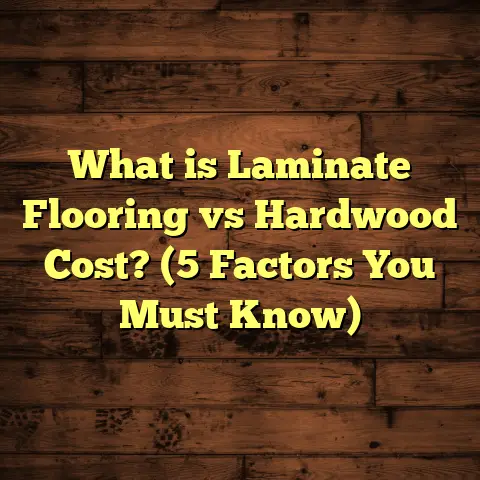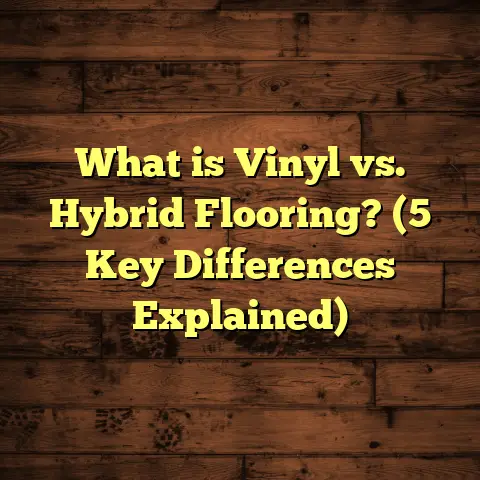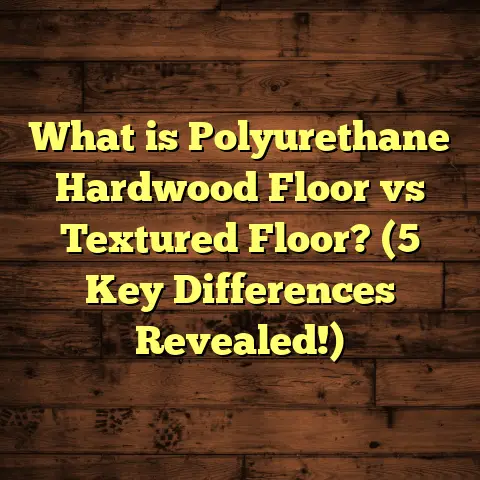What is a Floor Finish? (5 Types to Elevate Your Space)
I often find myself in conversations with homeowners who are feeling overwhelmed by their flooring choices. The question I hear most frequently is, “What should I do to make my floors not only look good but also perform well?” It can be a real conundrum, especially with so many options out there. Today, I want to talk about one aspect that often gets overlooked but is absolutely vital: floor finishes.
Floor finishes not only enhance the beauty of your flooring but also protect it from wear and tear. I remember the first time I installed hardwood floors in my own home. I was so excited about the rich colors and natural grain patterns. But after a few months, those floors started to show signs of scratches and scuffs. That’s when I learned the hard way about the importance of a good finish.
Let me share what I’ve learned over the years about different types of floor finishes and how they can transform your space.
Why Floor Finish Matters
You might be wondering, why does the finish matter so much? Well, a quality finish can extend the life of your flooring and keep it looking new for years. Think of it like putting a protective coat on your favorite piece of furniture. Just like you wouldn’t leave a wooden table unprotected, your floors deserve the same level of care.
The Protection Factor
Statistically speaking, homes with well-finished floors can last 30% longer than those without finishes. That’s a significant difference! The right finish can protect against moisture, stains, and scratches.
The Different Types of Floor Finishes
Now, let’s discuss five popular types of floor finishes I’ve encountered, each with its unique benefits.
1. Polyurethane Finish
Polyurethane is a popular choice among homeowners and contractors alike. This finish provides excellent durability and is resistant to water and scratches. When I first used polyurethane on a client’s oak floors, they were thrilled with the results. The floors had a beautiful sheen that brought out the wood’s natural color, and the clients were relieved knowing they wouldn’t have to worry about spills or heavy foot traffic damaging their investment.
One thing to keep in mind is that there are both oil-based and water-based polyurethanes. Oil-based options tend to provide a thicker finish and take longer to dry, whereas water-based products dry quickly and have lower VOC emissions. Personally, I prefer water-based finishes for residential projects because they are less toxic and cause fewer odors during application.
2. Oil Finish
Oil finishes offer a more natural look while allowing the wood to breathe. They penetrate deeply into the wood fibers, enhancing its color and grain without creating a thick surface layer. I remember working on a rustic cabin where we used an oil finish on reclaimed wood floors. The result was stunning; the finish accentuated the character of the wood beautifully.
However, oil finishes require more maintenance than other options. Regular reapplication is necessary to maintain their protective qualities, but for some homeowners, this is a small price to pay for such an authentic look.
3. Lacquer Finish
Lacquer finishes provide a high-gloss look that many people love for modern spaces. They dry quickly and create a hard surface that’s resistant to scratches and stains. I once completed a project in a contemporary loft where lacquer was used on polished concrete floors. The effect was striking—reflecting light beautifully and making the space feel larger.
It’s important to note that while lacquer is durable, it can be more challenging to repair than other finishes if it gets damaged. A small scratch can require refinishing the entire area, which can be a hassle.
4. Varnish Finish
Varnish is another great option that combines the benefits of both oil and polyurethane finishes. It dries clear and provides excellent resistance to UV light, making it perfect for areas with lots of sunlight. I once worked on a sunroom where we chose varnish for its ability to withstand fading from prolonged exposure to sunlight. The homeowners were thrilled with how well it held up over time.
One thing to watch out for is that varnish can become yellow over time, especially in high-UV environments, so it’s advisable to choose high-quality products designed specifically for your use case.
5. Wax Finish
Wax finishes are often overlooked but can add a lovely touch to certain types of wood flooring. They provide a warm glow and are relatively easy to apply and maintain. In fact, I once restored an old farmhouse floor using wax, and it brought out the beauty of the wood in such an appealing way.
However, wax finishes require regular upkeep—think reapplication every few months—to maintain their protective qualities. They’re best suited for low-traffic areas or spaces where aesthetics take precedence over durability.
Choosing the Right Finish for Your Space
So how do you choose the right finish for your flooring project? It really depends on several factors:
- Traffic Levels: If you have pets or kids running around, you might want something durable like polyurethane.
- Aesthetic Preferences: If you’re going for a rustic or vintage look, oil or wax finishes could be more appealing.
- Maintenance Willingness: How much time are you willing to invest in upkeep? Some finishes require more maintenance than others.
- Environmental Concerns: If low VOCs are important to you, consider water-based options.
I always recommend talking to a flooring expert before making your decision—someone who can guide you based on your specific needs.
Personal Anecdotes and Insights
Let me share some personal experiences that shaped my perspective on floor finishes.
A Client’s Journey
I remember working with a client named Sarah who was passionate about eco-friendly living. She wanted hardwood floors but was concerned about choosing a finish that would be safe for her family and the environment. After discussing her options, we decided on a water-based polyurethane finish that met her standards for sustainability while providing durability.
As we completed the project, Sarah was thrilled with how the finish enhanced the natural beauty of her flooring without compromising her values. It was rewarding to see how much she appreciated the final result—a beautiful home that aligned with her beliefs.
A Lesson Learned
In another instance, I took on a renovation project in an older home where the owners wanted to preserve as much of the original charm as possible. We opted for an oil finish on their vintage oak floors to highlight the natural grain and character of the wood. However, we quickly learned that maintaining an oil finish requires diligence. The owners found themselves reapplying oil every few months to keep their floors looking fresh.
This experience taught me that while oil finishes can be stunningly beautiful, they also demand commitment from homeowners who choose them.
Statistical Insights
According to industry research, around 70% of homeowners prioritize durability when selecting floor finishes. Additionally, homes with high-quality finishes tend to have higher resale values—up to 15% more than those without proper protection. These statistics highlight why investing in a quality floor finish is not just about aesthetics but also about long-term value.
Maintenance Tips for Different Finishes
No matter which finish you choose, proper maintenance is key to keeping your floors looking great. Here are some tips based on my experiences:
Polyurethane Finish Maintenance
- Regular Cleaning: Sweep or vacuum regularly to remove dirt and debris.
- Damp Mopping: Use a damp mop with a pH-neutral cleaner every few weeks.
- Avoid Harsh Chemicals: Steer clear of abrasive cleaners that can damage the finish.
Oil Finish Maintenance
- Reapplication: Plan to reapply oil every 3-6 months depending on traffic.
- Gentle Cleaning: Use a soft cloth or dust mop for daily cleaning.
- Avoid Excess Water: Too much moisture can damage oil-finished floors.
Lacquer Finish Maintenance
- Dust Regularly: Use a microfiber cloth or soft broom.
- Spot Cleaning: Wipe up spills immediately to prevent staining.
- Repair Scratches: Keep repair kits handy for quick touch-ups.
Varnish Finish Maintenance
- Periodic Reapplication: Depending on wear, consider reapplying varnish every 1-3 years.
- Cleaning Solutions: Use gentle cleaners designed for varnished surfaces.
- Protect Against UV: Use rugs or curtains in sunny areas to minimize fading.
Wax Finish Maintenance
- Frequent Reapplication: Wax surfaces typically need reapplication every few months.
- Gentle Cleaning: Use a damp cloth or mop; avoid soaking.
- Buffing: Regularly buff the waxed surface to restore shine and protect it from wear.
Case Studies
Case Study 1: The Busy Family Home
In one project, I worked with a family of four who had two young children and a dog. They were concerned about keeping their floors looking good while managing daily wear and tear. We opted for polyurethane because of its durability against scratches and spills.
After two years, I checked back in with them during routine maintenance. The floors still looked fantastic! They shared stories about how easy it was to clean up after messes—definitely worth it!
Case Study 2: The Eco-Friendly Retreat
Another client wanted their vacation home finished with sustainable materials. We chose an oil finish for its natural appearance and non-toxic properties. Initially hesitant about upkeep, they soon found joy in maintaining their floors as part of their weekend routine.
After several seasons of use, they reported back with glowing reviews about how easy it was to apply oil and how beautiful their floors remained—something they loved showing off during family gatherings!
Conclusion
Investing in high-quality floor finishes is essential for preserving the beauty and longevity of your flooring choices. Each type has its unique characteristics that cater to different lifestyles and preferences.
Reflecting on my experiences working with various clients has reinforced my belief in the importance of selecting the right finish. From busy families needing durability to eco-conscious homeowners wanting sustainability, there’s truly something for everyone.
If you’re considering new flooring or refinishing an existing one, take your time exploring your options—understanding how each finish can impact your home will empower you to make informed decisions that enhance both beauty and function.
What type of finish do you think suits your space best? Let’s discuss!





